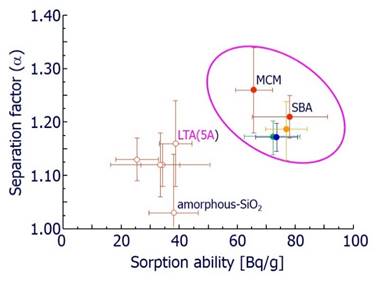Hydrogen Isotope Science for Environment
Staff:
TAGUCHI Akira
Personal
The separation of hydrogen isotopes, including hydrogen (H, or protium), deuterium (D), and tritium, is important in fusion engineering, where tritium and D have long been regarded as potential fuels for nuclear fusion reactors. These isotopes also have other potential applications, for example, the D-labeled pharmaceutical compounds that exhibit novel properties.
Our group have working in the hydrogen isotope separation using Porous Materials. We have found that mesoporous silicas (MCM-41 and SBA-15) show larger tritium adsorption ability and separation factor as compared to the conventional microporous zeolites. These properties for tritium enrichment could be improved by organically functionalization.
 High surface area of mesoporous silica is attractive as functional adsorbates. We have found an intrinsic character of MCM and SBA for sorptive removal/enrichment of tritium from tritiated water. Figure shows a relation of tritium adsorption ability and separation factor of mesoporous materials and zeolites in solid-liquid sorption studies. Clearly seen that mesoporous silicas (MCM and SBA) have distinctive tritium adsorption and separation properties as compared to the conventional microporous zeolites (FAU, LTA, MOR). From MAS NMR and FT-IR studies, such difference was found to be attributed from the difference of enrichment mechanism. That is, for microporous zeolites, the diffusion of water molecule is dominant for HTO/H2O separation. On the other hand, for MCM and SBA, the hydrolysis reaction of silica wall with HTO molecule is the key factor for accumulative enrichment of tritium from tritiated water.
High surface area of mesoporous silica is attractive as functional adsorbates. We have found an intrinsic character of MCM and SBA for sorptive removal/enrichment of tritium from tritiated water. Figure shows a relation of tritium adsorption ability and separation factor of mesoporous materials and zeolites in solid-liquid sorption studies. Clearly seen that mesoporous silicas (MCM and SBA) have distinctive tritium adsorption and separation properties as compared to the conventional microporous zeolites (FAU, LTA, MOR). From MAS NMR and FT-IR studies, such difference was found to be attributed from the difference of enrichment mechanism. That is, for microporous zeolites, the diffusion of water molecule is dominant for HTO/H2O separation. On the other hand, for MCM and SBA, the hydrolysis reaction of silica wall with HTO molecule is the key factor for accumulative enrichment of tritium from tritiated water.
Modification of mesopore wall by organic functional group is as good option for improvement of sorption abilities. We have also studied the tritium enrichment activity by -SO3H, -COOH or -NH2 groups modified SBAs. As the tritium sorption ability and separation factor were plotted in Figure, organic functional group modified SBAs also showed a distinctive enrichment properties from microporous zeolites.
